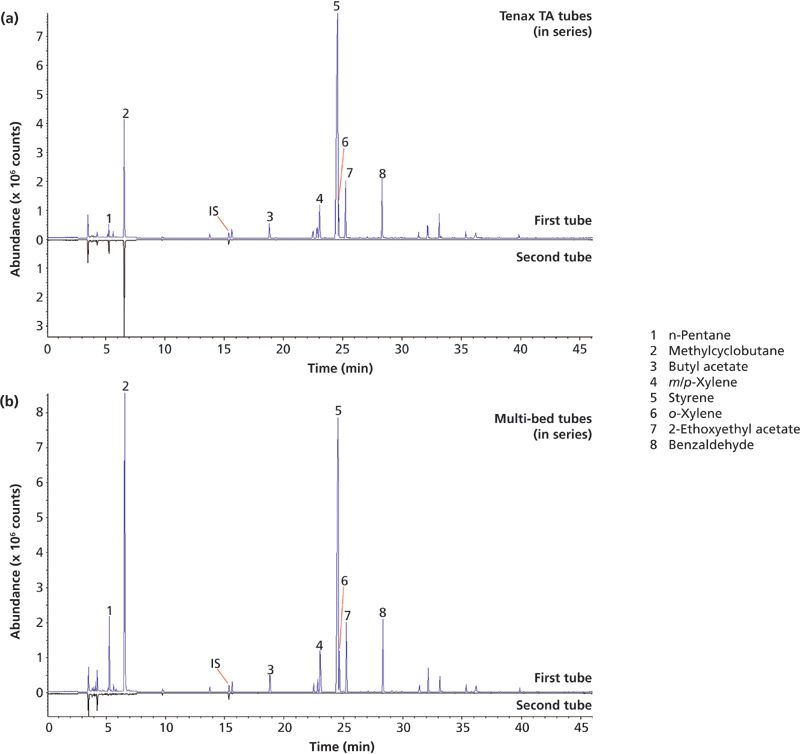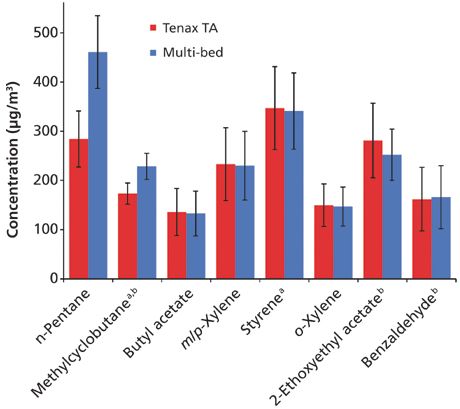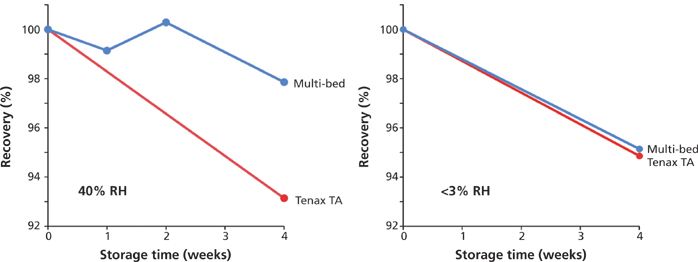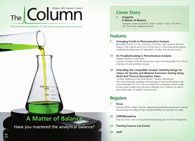Extending the Compatible Analyte Volatility Range for Indoor Air Quality and Material Emissions Testing Using Multi-Bed Thermal Desorption Tubes
This article describes sampling methodology for thermal desorption–gas chromatography (TD–GC) that can extend the compatible analyte range of tests used to determine chemicals released from materials, as well as associated indoor air quality measurements.
This article describes sampling methodology for thermal desorption–gas chromatography (TD–GC) that can extend the compatible analyte range of tests used to determine chemicals released from materials, as well as associated indoor air quality measurements. We summarize studies that demonstrate how packed multi-bed thermal desorption tubes, popular in environmental analysis, deliver improved recovery of very volatile compounds over single-bed tubes without compromising the recovery or stability of heavier target analytes.
Thermal desorption (TD) is a versatile gas chromatography (GC) pre-concentration technology that is applicable to the analysis of volatile and semi-volatile organic compounds (VOCs and SVOCs) in a wide range of sample matrices. As well as boosting sensitivity, it allows full automation of the processes of sample pre-concentration, desorption and extraction, and GC injection, greatly improving sample throughput.

Photo Credit: Tricia Shay Photography/Getty Images
The typical two-stage TD process, used for concentrating volatiles from relatively large volumes of air or gas, involves the gentle heating of sorbent-packed TD tubes in a flow of inert carrier gas, with the released components being swept into an electrically-cooled focusing ("cold") trap within the TD system. The focusing trap is then heated rapidly in a reverse flow of carrier gas to inject the organic compounds into the GC column as a sharp band of vapour. This two-stage desorption process optimizes concentration enhancement and produces narrow chromatographic peaks, thus optimizing sensitivity.
The selection of sorbents for thermal desorption sampling tubes and focusing traps involves the consideration of a range of factors, including the strength of the sorbent–sorbate interaction, artefacts, hydrophobicity, inertness, and mechanical strength. Packed with appropriate sorbent(s), a TD sampling tube can allow quantitative retention and release of compounds ranging from C2 hydrocarbons and freons to semi-volatiles such as PCBs, phthalates, and PAHs, without exceeding optimized tube dimensions or requiring liquid cryogen coolant.
Material emissions test methods have traditionally been targeted at relatively narrow analyte ranges - typically from n-hexane to n-C16 or, in some cases, from n-hexane to n-C22. Such methods typically use tubes packed with Tenax TA,1,2 and although this sorbent has many desirable qualities (for example, hydrophobicity, low inherent artefacts, good recovery of semi-volatiles, and inertness), it is not suitable for some very polar compounds, and is too weak for quantitative retention of species more volatile than n-hexane.
Therefore, with the growing demand to measure very volatile and semi-volatile toxic compounds, increasing attention has been given to the use of sampling tubes packed with additional sorbents.3,4 In these so-called "multi-bed" tubes, up to four sorbents are arranged in order of increasing strength from the sampling end, so that the less volatile "sticky" components only encounter the weakest sorbent, and are easily released when the gas flow is reversed during the subsequent thermal desorption process. This allows a wider volatility range of components to be quantitatively sampled and analyzed.
Although such multi-bed sorbent tubes are commonly used in ambient (outdoor) air monitoring,5 their deployment for material emissions testing and indoor air quality monitoring has historically been limited. However, a recent revision of a key international standard method1 includes the option to use multi-bed sorbent tubes. This article describes studies that assessed the effectiveness of these tubes against the single-bed tubes more widely used in this field.
Experimental
The protocols used are briefly summarized here. Full details can be found in the cited references.
All experiments used stainless steel 3½" × ¼" sorbent tubes (Markes International), packed either with Tenax TA or with quartz wool–Tenax TA–Carbograph 5TD. All tubes were stringently conditioned before use using a TC-20 off-line tube conditioner (Markes International). The conditioned tubes were capped prior to and after sampling with two-piece brass long-term storage caps fitted with PTFE ferrules.
A Micro-Chamber/Thermal Extractor (Markes International) was used to sample volatiles emitted by polyurethane (PU) foam onto the sorbent tubes, followed by analysis using a TD-100 automated thermal desorber (Markes International) with gas chromatography (GC) (Agilent Technologies) coupled to MS (Agilent Technologies).

Emissions from Polyurethane (PU) Foam:6 PU foam was freshly cut from a composite door known to release a mixture of very volatile organic compounds (VVOCs), VOCs, and SVOCs. Material samples were placed into individual micro-chambers equilibrated at 23 °C and the emissions sampled onto the two types of sorbent tube. Two identical tubes, in series, were used in each case - a front "sampling" tube, and a rear "back-up" tube to collect any analytes that broke through. Sampling conditions were (a) 60 min with an air flow of ~80 mL/min, to generate the chromatograms shown in Figure 1, and (b) 15 min with an air flow of 50 mL/min, to generate the mean values shown in Figure 2.

Stability Studies:7 To generate the results shown in Figure 3, a mixture of chemical standards relevant to material emissions testing was loaded onto sorbent tubes in the gas phase (with or without methanol, as necessary) to give a nominal loading of 100 ng for each component, with a bubbler used to generate humid atmospheres.

Results and Discussion
Figure 1 compares emissions from the PU foam sample sampled using the two types of tube. It is immediately apparent that the multi-bed tubes show better recovery of the lightest analytes, n-pentane (b.p. 36 °C) and methylcyclobutane (b.p. 36 °C), with no detectable breakthrough of either analyte on the respective back-up tubes.
These results are confirmed by the analysis shown in Figure 2, which used the same setup except with a lower flow rate and shorter sampling time, more typical of a standard sampling protocol.
In the past, there have been concerns that, during storage, less volatile analytes might migrate from weaker sorbents to stronger sorbents within multi-bed tubes - a phenomenon that would result in compounds being irreversibly bound to the stronger sorbent. However, the 4-week stability data presented in Figure 3 shows that the performance of the multi-bed sorbent tubes was at least equal to that of the Tenax TA tubes. It is worth noting that, whatever the sorbent combination used, it is still advisable to analyze tubes as soon as possible after sampling, and ideally within four weeks.
Conclusions
These results demonstrate that multi-bed sorbent tubes packed with quartz wool, Tenax TA, and Carbograph 5TD are compatible with an extended analyte range compared to single-bed Tenax TA tubes. As well as allowing simultaneous active/pumped sampling of volatiles from n-butane to n-C30, the stability of a number of volatile analytes is found to be very similar on both tube types, confirming the suitability of these multi-bed tubes for a range of TD applications.
Acknowledgement
The kind assistance of Dr Derrick Crump and Dr Veronica Brown (Cranfield University, UK) in supplying the data for this article, and in reviewing a draft, is gratefully acknowledged.
References
1. ISO 16000: Indoor air. Part 6: Determination of volatile organic compounds in indoor and test chamber air by active sampling on Tenax TA sorbent, thermal desorption and gas chromatography using MS or MS-FID. Annex D specifies multi-bed sorbent tubes packed (as in this study) with quartz wool–Tenax TA–Carbograph 5TD, as an alternative to single-bed Tenax TA tubes.
2. EN TS 16516: Construction products: Assessment of emissions of regulated dangerous substances from construction products – Determination of emissions into indoor air.
3. Application Note 005: Advice on sorbent selection, tube conditioning, tube storage, and air sampling, Markes International, April 2014, http://www.markes.com/Resources/Application-notes/default.aspx.
4. E. Woolfenden, Journal of Chromatography A 1217, 2685–2694 (2010), http://dx.doi.org/10.1016/j.chroma.2010.01.015
5. US EPA Method TO-17: Determination of volatile organic compounds in ambient air using active sampling onto sorbent tubes.
6. V.M. Brown and D.R. Crump, Analytical Methods5, 2746–2756 (2013), http://dx.doi.org/10.1039/c3ay40224j
7. V.M. Brown, D.R. Crump, N.T. Plant, and I. Pengelly, Journal of Chromatography A1350, 1–9 (2014), http://dx.doi.org/10.1016/j.chroma.2014.05.011
Caroline Widdowson is the product marketing manager for thermal desorption at Markes International, having completed her chemistry degree at Cardiff University in 2004, followed by a Ph.D. in organic chemistry. As part of her current role, she works closely with manufacturers, test laboratories, and research institutes to advise analytical chemists on sampling, analysis, and regulations surrounding the release of chemicals from materials indoors or in vehicles.
David Barden is a technical copywriter at Markes International, having joined the company in 2011. David studied natural sciences at the University of Cambridge, UK, and remained there for his Ph.D. in organic chemistry, which he received in 2003. A placement at the European Journals Department of Wiley-VCH, Weinheim, Germany, was followed by seven years as a technical editor for various scientific journals at the Royal Society of Chemistry, Cambridge, UK.
E-mail: enquiries@markes.com
Website: www.markes.com
This article is from LCGC's digital magazine, The Column. Click here to view the issue.

Study Examines Impact of Zwitterionic Liquid Structures on Volatile Carboxylic Acid Separation in GC
March 28th 2025Iowa State University researchers evaluated imidazolium-based ZILs with sulfonate and triflimide anions to understand the influence of ZILs’ chemical structures on polar analyte separation.
Quantifying Microplastics in Meconium Samples Using Pyrolysis–GC-MS
March 26th 2025Using pyrolysis-gas chromatography and mass spectrometry, scientists from Fudan University and the Putuo District Center for Disease Control and Prevention detected and quantified microplastics in newborn stool samples.












